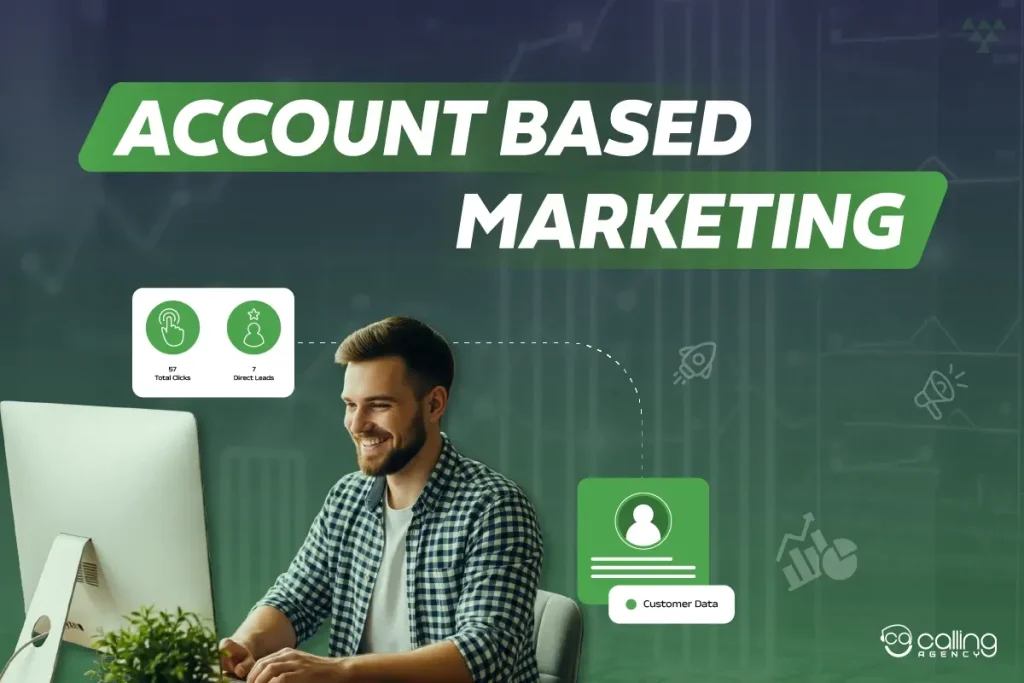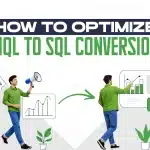Account-based marketing has evolved over the years, but there is still a missing puzzle piece in using the right account-based marketing metrics.
Believe it or not, many companies end up using traditional demand gen “performance indicators” to gauge the success of the ABM efforts. This is not the right approach! As the saying goes, “ You can’t improve what you don’t measure”, and in the curious case of ABM metrics, you cannot enhance if you measure with the wrong metrics.
ABM Strategy is leveraged to achieve extremely specific results. The objectives and the corresponding strategy can be very bespoke. By adopting intent data, AI Analytics, personalization and robust ABM measurement, you will be able to position your organization to capture more value from each value account.
What Is Account-Based Marketing?
For Business-to-Business (B2B) Lead Generation, it can be difficult to convert high-value leads into customers. The core is to create a personalized customer experience that not only will convert more B2B decision-makers but also generate a higher return on investment.
Through a focus on building stronger relationships with high-value accounts, Account-Based Marketing in B2B needs to increase pipeline quality, retain top accounts and boost the revenue that those accounts bring in.
This approach flips the traditional method of inbound marketing on its head. Rather than working to attract a large number of prospects and then develop niche content to move ideal prospects through a funnel. Account-Based Marketing strategies usually initiate at the bottom of the funnel.
- Personalized Marketing
- Build and Nurture Customer Relationships
- Align Marketing and Sales Teams
- Accelerate Sales Cycles
- Maximize Relevance Among High-Value Accounts
- Higher Marketing ROI
For example, you might track who visits your website or research prospects and then develop content and marketing campaigns specifically targeted to that institution. This is what makes ABM so different from other marketing strategies.
Who Should Use ABM And When
ABM is a must for revenue-focused businesses. It hones in on high-value accounts and aligns marketing and sales to craft personalized strategies that target key prospects. By targeting the right decision-makers, ABM speeds up sales and increases conversions.
Marketers integrate ABM to achieve and retain key accounts by creating tailored content and experiences for specific companies and their key individuals. Companies use ABM when they want to increase sales revenue by building strong relationships with high-value accounts that are a perfect fit for their offerings and to increase pipeline quality.
Some of the most common ABM users are:
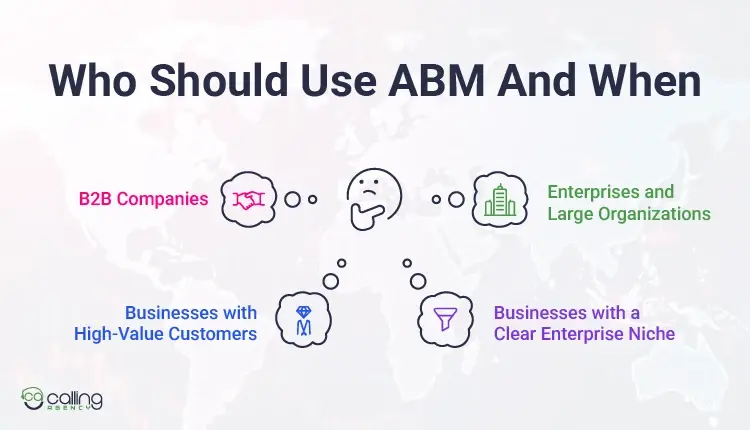
- B2B Companies
- Enterprises and Large Organizations
- Businesses with High-Value Customers
- Businesses with a Clear Enterprise Niche
Types Of ABM (1:1, 1:Few, 1:Many)
The goal of ABM is to focus on customer segments that have the highest likelihood of converting into clients or strengthening the relationships with existing customers.
Let’s look at the three different types of ABM, the goals they suit best and what type of content you would produce for each.
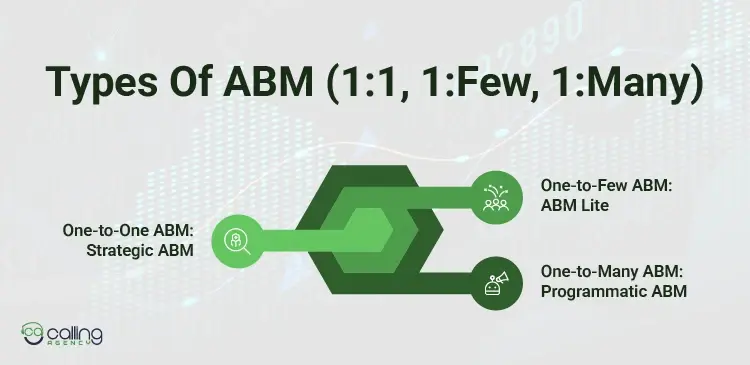
One-to-One ABM: Strategic ABM
This intensive operating model targets a single high-value account at a time, which necessitates a highly personalized and human approach. It enhances customer relationships by treating each account uniquely, deepening connections and increasing customer lifetime value with tailored interactions that boost retention. A successful Strategic ABM approach usually follows the following steps:
- In-Depth Research
- Custom Messaging Development
- Personalized Engagement
One-to-Few ABM: ABM Lite
In ABM Lite, a small group of accounts are clustered together for targeted campaigns. The cluster might range from five to ten accounts that demonstrate common traits, challenges or industry backgrounds. This mid-tier strategy offers a compromise and maintains a level of personalization higher than Programmatic ABM while requiring fewer resources than Strategic ABM.
The focus is split 50:50 on existing and new opportunities with programs being arguably as resource-heavy as 1:1 ABM. This is a flexible approach that pivots according to results. Hence, it makes it perfect for companies with agile resources.
This approach enables marketers to implement semi-customized campaigns and optimize resource use to ensure that each account cluster receives attention tailored to its shared characteristics.
- Segmentation and Targeting
- Customized Campaign Development
This approach is particularly useful for companies with moderate marketing resources and allows them to efficiently focus their efforts on narrowly defined segments that closely resemble their ideal customer profiles (ICP).
One-to-Many ABM: Programmatic ABM
One-to-many ABM targets multiple accounts (hundreds or thousands) simultaneously, relying on technology to support complex and automated campaigns. It emphasizes engaging a broader audience through automated and data-driven strategies. It is designed to enable organizations to efficiently extend their reach across numerous prospective accounts.
Programmatic ABM conducts the following key steps to target and engage potential accounts at scale:
- Define Target Accounts
- Build the Marketing Technology Stack
- Collect and Enrich Data
- Segment and Prioritize Accounts
- Orchestrate Multi-Channel Campaigns
- Automate Execution and Optimization
- Integrate with Sales
- Measure and Analyze
This approach not only enhances efficiency but also empowers organizations to address a larger audience with tailored engagements and optimize resource allocation and potentially amplify conversion effectiveness.
| Feature | Strategic ABM | ABM Lite | Programmatic ABM |
| Target audience | Few (1-50) high-value accounts | Groups (50-500) with similar needs | Hundreds to thousands of accounts |
| Personalization | Very high; tailored to each account | Segment-based personalization | Broad, automated personalization |
| Complexity | High; individual account focus | Moderate; segment-level strategy | Low; technology-driven |
| Resources | Resource-heavy; intensive personalization | Less intense than strategic; segment focus | Least intense; automation-focused |
| Tools | Advanced CRM, content tools, analytics | Scalable CRM and content tools | Automation tools, programmatic ads, AI analytics |
| Objective | Deepen relationships via tailored interactions | Convert segments with similar needs | Engage a wide audience efficiently |
| Sales alignment | Close, deep engagement with accounts | Collaborative; targeted account segments | Informed; automated prioritization |
| Metrics | Qualitative, deep engagement analysis | A mix of qualitative and quantitative | Quantitative; performance metrics
|
| Top tactics | 1. Bespoke events
2. Tailored content 3. Direct mail 4. Personalized outreach 5. Account insights |
1. Webinars
2. Email campaigns 3. Targeted content 4. Social media engagement 5. Targeted ads |
1. Digital ads
2. Dynamic emails 3. Programmatic ads 5. Lookalike audience targeting |
ABM vs. Demand Gen vs. Inbound
The purpose of ABM is to engage the decision-makers and the influencers in the selected accounts. It attempts to satisfy the information needs of those who can affect a purchasing decision at each stage of the sales process. The benefits of Account-Based Marketing are:
- It improves sales closure rates.
- It improves marketing alignment with sales.
- It minimizes wasted sales and marketing resources.
- It improves the supplier’s reputation.
- It reduces friction between seller and buyer.
Demand Generation is the holistic and data-driven approach to creating and nurturing your products and services. It is the digital equivalent of casting a wide net in the hopes of capturing leads who may not yet be aware of what you’re offering.
Inbound Marketing draws in potential customers with valuable and relevant content. You catch people’s attention with events, blogs and social media posts that answer their questions, solve a problem or simply build connections. Instead of focusing on closing sales, you make it your mission to empower your audience and help them meet their goals.
Key Differences
| Criteria | Account-Based Marketing (ABM) | Demand Gen | Inbound Marketing |
| Target Audience | Focuses on a specific set of high-value accounts. | Groups with similar interests, intent & demographic information | Aims to attract a broader audience through valuable content. |
| Personalization | Highly personalized messaging tailored to each account. | Prospect data to deliver tailored content, messaging & experiences | Broadly personalized based on buyer personas. |
| Sales Cycle | Best suited for long, complex sales cycles. | Broad and continuous process | Works well for shorter sales cycles with self-guided education. |
| Alignment with Sales | Strong alignment between marketing and sales teams. | Unified approach with shared goals, communication and processes | Moderate alignment, with a focus on marketing-driven leads. |
| Scalability | Limited scalability due to its account-specific nature. | Scalable using strategies and tools | Scalable, can reach a wide audience with minimal incremental effort. |
| Metrics | Account-level metrics such as engagement and pipeline growth. | Key metrics include Marketing Qualified Leads (MQLs), Sales Qualified Leads (SQLs), Lead Conversion Rates and Activations and Signups | General metrics like website traffic, lead generation, and conversions. |
| ROI | Often provides a higher return for high-value accounts. | Attracts more customers, increasing ROI | Cost-effective, especially for companies with smaller budgets. |
ABM Strategy: Step-By-Step
This method is particularly effective in the professional services sector, where personalized communication and deep client relationships are essential. Whether you are just getting started or looking to enhance your existing program, this comprehensive framework will help you achieve your goals!
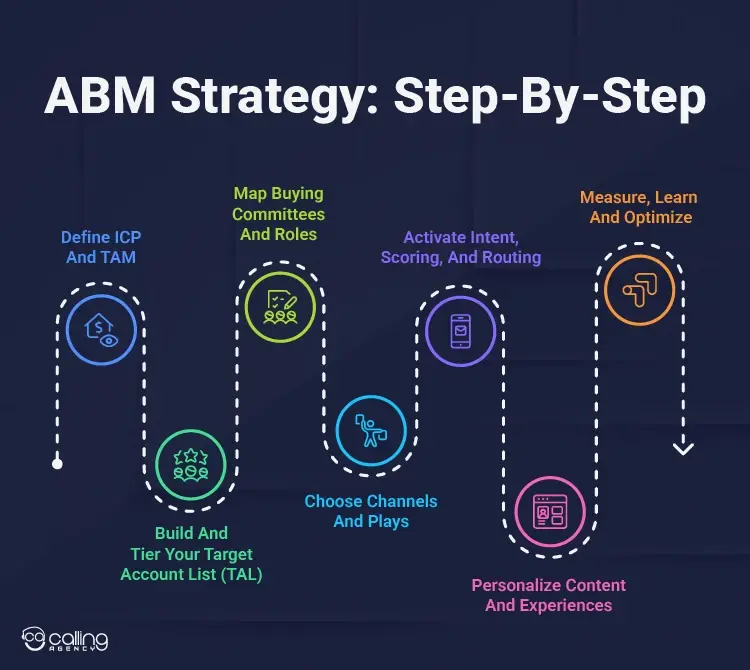
Define ICP And TAM
An ideal customer profile (ICP) is an archetype of the companies that would realize the most value from your product or service and, in turn, generate repeatable and scalable business. Total Addressable Market (TAM) refers to the total market possible for a product or service, indicated by an estimate of a specific market’s revenue potential.
Build And Tier Your Target Account List (TAL)
A target account list is a curated list of high-value businesses that represent your ideal customers. TAL focuses on your entire go-to-market team’s efforts on the accounts most likely to convert and deliver long-term value. A well-constructed target account list includes the following:
- Company Name
- Industry
- Company Size
- Decision-Makers and Influencers
- Buying Stage
- Prior Interactions or Engagement
- Potential Revenue Impact
It will help you increase the effectiveness of your outreach efforts and drive meaningful results.
Map Buying Committees And Roles
A map-buying committee consists of a group of people who are responsible for making decisions about what to purchase on behalf of an entire organization. The committee includes representatives from different departments (Finance, IT, Management & Operations) and are also responsible for researching, evaluating and selecting vendors.
It is a collaborative process that ensures everyone’s insights are considered, that leads to a unified choice.
Choose Channels And Plays
Selecting the optimal marketing channel is about aligning your brand with your audience in an environment where they are most receptive. The right marketing channel significantly impacts the business growth, customer acquisition and overall brand visibility.
A solid channel strategy decides how and where to connect with your audience. Whether it is through paid ads, email, socials, in-store promotions or entirely something else.
The success of a marketing channel is determined by its ability to drive relevant traffic, generate leads and convert them into loyal customers. Consider the following steps to ensure the effectiveness of your marketing channels.
- Audience Reach
- Audience Engagement
- Cost-Effectiveness
- Brand Alignment
- Customer Preference
- Conversion Potential
- Data Accessibility
Activate Intent, Scoring, And Routing
Intent data becomes most valuable when it is embedded in every step of your go-to-market strategy. To activate intent, scoring and routing, apply scoring to prioritize leads based on their purchase intent and engagement level. And later on, route these prioritized leads to the appropriate sales or marketing team for targeted outreach.
There are two main types of intent data:
- First-Party Intent Data – This includes forms filled out for gated content or IP addresses collected from visitors.
- Third-Party Intent Data – This revolves around how users interact with digital channels that an organization doesn’t control. Most third-party vendors analyze data from content engagements on publisher sites where they’ve established relationships.
Personalize Content And Experiences
Content personalization is the process of tailoring marketing messages, website experiences and other customer interactions based on individual preferences, behaviors and demographics.
It is essential to strike a balance between personalization and staying current with the latest trends and best practices. Some of the most notable benefits of personalized content are:
- More Customer Engagement
- Achieve More Conversions
- More Loyal Customers
- Better Return On Investment
Measure, Learn, And Optimize
It is a way of thinking and working that helps you create products or services that solve real problems and deliver value to your customers. It builds a minimal viable product (MVP) based on your hypothesis, measures how it performs with real users and learn from the feedback the data to make informed decisions and iterate.
Account-Based Marketing Framework
This framework is a B2B Strategy where the sales and marketing teams align to target and engage a selected group of high-value accounts that treat each other as a “market of one” with a highly personalized and coordinated campaign to gain a higher revenue on investment and drive deeper relationships.
The marketer’s framework for Account-Based Marketing is:
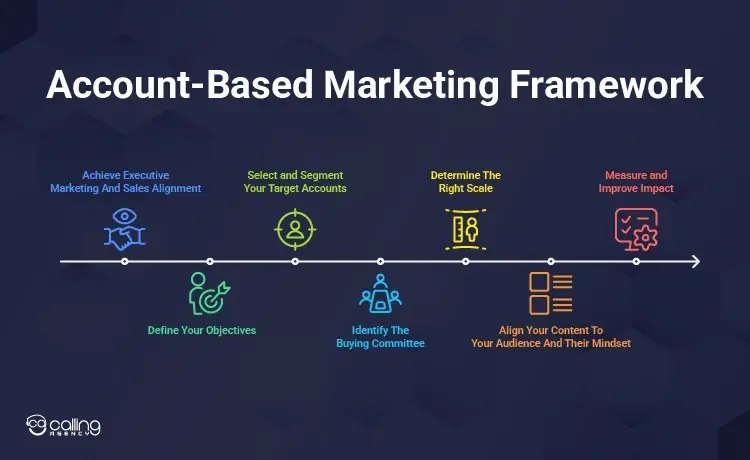
- Achieve Executive Marketing And Sales Alignment
- Define Your Objectives
- Select and Segment Your Target Accounts
- Identify The Buying Committee
- Determine The Right Scale
- Align Your Content To Your Audience And Their Mindset
- Measure and Improve Impact
ABM Tech Stack (Core And Optional)
The tools used to create an ABM Stack fall into multiple categories, typically divided into four to eight essential sections. Enterprises need a connected ABM tech stack with these six core tools:
- Intent Data and Account Intelligence
- ABM Platforms
- Data Enrichment
- Personalization Tools
- Advertising Solutions
- Analytics Platforms
ABM Tech Stacks empower marketers to navigate the complexities of the buying journey that aligns closely with the sales team and demonstrates clear ROI on their marketing investments.
ABM Metrics And KPIs
Metrics: Quantitative measures track and assess specific activities or processes such as email open rates or website traffic. It monitors the execution of daily activities and operational efficiency, and can be tracked in real-time or over short periods to provide immediate feedback on specific aspects of performance.
KPIs: High-level measures are essential for strategic planning and decision-making. These are typically reviewed over longer time periods, such as quarterly or annually, to assess progress toward a larger business goal.
Common ABM Mistakes (And Fixes)
ABM done right is a sure-fire way to revenue growth. But you can also have the whole thing tumbling down if you don’t watch out for the following common mistakes.
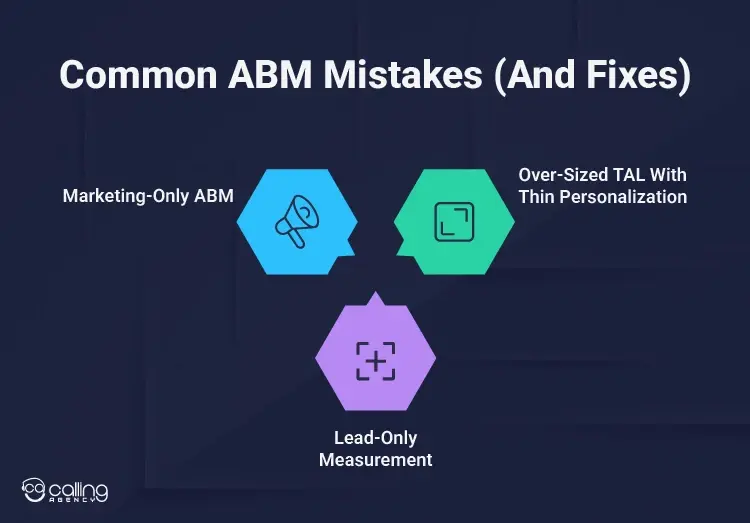
Over-Sized TAL With Thin Personalization
It is an inefficient ABM Strategy where a large number of accounts are targeted with generic and non-specific content. It is ineffective because of a lack of focus, generic messaging, wasted resources and low conversion rates.
To improve this strategy, refine your ideal customer profile, tier your accounts, conduct deep research, develop personalized messaging and utilize ABM Platforms.
Lead-Only Measurement
It tracks predictive metrics that are forward-looking and controllable and rather than lagging indicators that only report past results. This approach includes focusing on specific activities and outcomes that will drive success towards a goal.
Marketing-Only ABM
It is led primarily by the marketing team to target and engage high-value accounts. The goal is to treat each account as a unique “market of one” and deliver tailored messages to build stronger relationships and drive revenue from those key accounts.
Conclusion
There are so many ways to embrace account-based marketing in your business. This marketing strategy is a great way to use your resources more efficiently by aligning sales and marketing teams to convert your high-value prospects into customers.
The state of Account-Based Marketing data in 2025 can be summed up in one word: Empowering. Never before have B2B Companies had such capabilities to pinpoint their ideal prospects, understand their needs through data and engage them with tailored outreach strategies across multiple channels.
Here’s to scaling your B2B Business success with the power of Account-Based Marketing!
FAQ
What are the key components of a successful ABM strategy?
The key components of a successful ABM Strategy include account identification and research, sales and marketing alignment, personalized content and messaging, targeted channel strategy, performance measurement and optimization and a robust tech stack.
How do you identify high-value accounts for ABM?
You can identify high-value accounts for ABM by identifying your Ideal Customer Profile (ICP), leveraging your data and existing pipeline by analyzing the CRM data, evaluating recent deals and mining your sales pipeline, using buyer intent data, considering strategic importance and relationships and collaborating with your sales team.
What industries benefit most from ABM?
Industries that benefit the most from ABM are technology, manufacturing, healthcare, financial services, and professional services. ABM is ideal for these industries because of their complex buying processes, high-value products or services, unique pain points, well-defined ICPs and the need for sales and marketing alignment.
How is ABM different from traditional B2B marketing?
Traditional B2B Marketing targets broader audiences with more generalized content, has cost-effective scalability and a lack of precision to generate leads and ABM focuses on a few high-value accounts with personalized campaigns. ABM also has a relationship-centric approach and typically aligns its sales and marketing.
What metrics should be tracked in ABM campaigns?
The metrics that should be tracked in ABM Campaigns are Account Engagement Metrics (Account Engagement Score, Account Progression Rate & Content Engagement by Account), Revenue and Financial Metrics, Pipeline and Sales Metrics and a couple of lesser essential metrics like Marketing Qualified Accounts (MQAs) and Account Penetration Rate.
How do you align sales and marketing for ABM?
To align sales and marketing for ABM define and establish shared goals and target accounts, foster an open communication and collaboration, leverage shared technology, develop joint strategies and techniques and focus on continuous improvement.
What are common ABM challenges and how to overcome them?
Some of the most common ABM challenges and how to overcome them:
1. Sales and Marketing Misalignment
Challenge: A significant obstacle is the detachment between sales and marketing teams that has different priorities and execution.
Solution: Foster a close collaboration from the initiation of the ABM Program by defining clear roles, shared goals and common metrics.
2. Identifying and Prioritizing Target Accounts
Challenge: Building an accurate accounts list and selecting high-value and relevant accounts that fit the ICP is difficult.
Solution: Integrate data analytics, CRM, predictive scoring and buyer personas to identify and prioritize accounts that show high potential.
3. Technology Integration and Management
Challenge: The ABM Stack can be complex with challenges integrating various tools like CRMs and marketing automation platforms.
Solution: Cautiously select and integrate the right ABM-dedicated tools that will make sure that they work seamlessly with existing systems to avoid complexity and workflow disruption.
Can small businesses implement ABM effectively?
Small businesses can implement ABM effectively by focusing on high-value accounts, leveraging existing resources and affordable tools and fostering a close sales and marketing alignment.
How to personalize content in an ABM strategy?
In order to personalize content in ABM strategy, you need to conduct in-depth account research by understanding pain points, map buyer personas and researching the industry, creating tailored content by developing industry-specific assets, producing personalized videos, building account-specific landing pages and utilizing dynamic content.
What’s the role of data in ABM success?
Data serves as a powerful asset for predicting needs, identifying risks and crafting proactive strategies that enhance engagement. Key roles of data include targeting and account prioritazation, personalization and messaging, intent signals and buyer readiness, campaign optimization, measuring and proving ROI and alignment with sales.
What are some ABM campaign examples?
Successful campaigns typically involve sales and marketing alignment through a multi-channel approach, built on tailored and engaging content that resonates with specific companies and decision-makers. Some campaign examples may include GUM GUM’S Burger Kit for personalized outreach and direct mail and Terminus’s Air Cover for tailored digital experiences.
How long does it take to see results from ABM?
The results may vary for early engagement metrics within a few weeks to months and with more significant business results and ROI emerging in a six to twelve-month range.
How do you scale an ABM program?
To scale an ABM Program, segment and tier target accounts into groups to allow for varying levels of personalization. You must ensure strong alignment across sales, marketing and IT teams by leveraging data and technology for insights, content personalization and multi-channel orchestration.
What is 1:1 vs 1:few vs 1:many ABM?
One-to-One Marketing targets a single, high-value account, while One-to-Few targets a smaller group of named accounts. One-to-Many Marketing targets a larger group of accounts through automated and data-driven methods.
What are the top ABM platforms in 2025?
The top ABM platforms in 2025 include Demandbase, 6sense and Terminus. These platforms provide comprehensive and AI-driven solutions for account identification, engagement and targeting.

